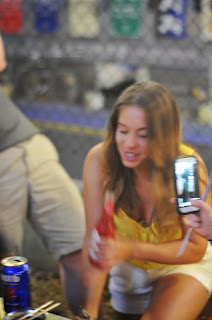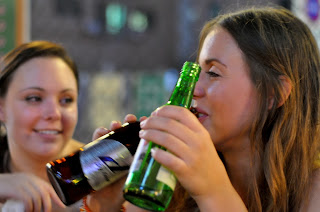Thursday,
December 11, 2014 I shared a cartoon that was published in the Times
Colonist that I interpreted to be racist towards the First Nations
communities in Victoria, BC. My words were met with a fair bit of
criticism, which I've come to expect with these sorts of things. I
have decided to delete the original post, along with the comments, as
I was requested to do so by an individual, and I will respect his
wishes. This doesn't mean that I want to censor anyone.. please
don't take that away from what I'm about to say.
I
want to be perfectly clear about why I did not like this comic, and
why I still do not like it, despite having read the artists reasons.
I
would like to start off by introducing myself. My name is Lauren
Micaela Petersen and I identify as a First Nations woman. I am Metis
on my mother's side, and consider that to be a gift. I may not be
from the Songhees nation, or Coast Salish, however I have had a
beautiful life growing up as a guest on their territory. Those are my
biases, they have helped to shape my views. This does not, by any
means, make me an authority on their culture. My words are my own,
and they reflect my views.
I
respect that the artist himself spoke out and acknowledged publicly
that he did not meet his mark on this. This has become a public
platform from which many individuals have chosen to express their
dislike for, or misinformation given about why we acknowledge
territory. I feel that people have gone too far with this, and have
forgotten to check themselves. We are all human, and we all have
much to learn.. so I am hoping, in some small part, that my words may
help this process.
Let's
start with the history. Needless to say if you are from British
Columbia you should be well versed in this, if you are not.. well...
it's a special case. BC was the last frontier of British North
America to be colonized. By the time the Western frontier was open to
settlers, there was already a systematic way of dealing with native
communities. Give up your resources, or be dealt with. Whether or or
not settlers of BC like to acknowledge it, many bands were conned out
of their land. Discussing this makes alot of new generation
Canadians VERY uncomfortable, and understandably. Nobody likes to
hear that they are a part of the problem, if they had no choice of
where their family settles. But what people do not realize is that
they have an opportunity to be a part of the solution.
The treaties that were drawn up to define what was crown land and what was not are largely disputed by First nations for many reasons, one of which is that the written language was not utilized traditionally within the context of First nations cultures... you could write anything you wanted down, then promise something entirely different using words, and any elders would sign an X. What many communities saw as a lease of land, was a transfer of property. This sort of behaviour would not be acceptable today, however it is what we go by today. This creates a lot of conflict, obviously. The history runs deeper than land theft.. there is a long history of racism, physical violence, and genocide. Those are topics deserving of much more attention than I can give, so I will leave you with supplementary information at the end of this blurb that touch on the Douglas treaties, BC residential schools, and the Stolen Sisters campaign that provides great information regarding the dehumanization of and sexual violence committed against Indigenous women in Canada.
My problem with the comic itself is two fold. My first issue is that the message was not clear. Initially, it appeared that the artist was making a comparison between the Nations who reside in and around the victoria area and insects. Many people shared this view, to the point where the Times Colonist demanded that the artist explain himself and issue an apology. It is as follows;
“The cartoon is about the empty mouthing of a mantra that appeases the non-indigenous conscience without any meaningful effort to make things better. It is a perfunctory statement not backed by action.
The treaties that were drawn up to define what was crown land and what was not are largely disputed by First nations for many reasons, one of which is that the written language was not utilized traditionally within the context of First nations cultures... you could write anything you wanted down, then promise something entirely different using words, and any elders would sign an X. What many communities saw as a lease of land, was a transfer of property. This sort of behaviour would not be acceptable today, however it is what we go by today. This creates a lot of conflict, obviously. The history runs deeper than land theft.. there is a long history of racism, physical violence, and genocide. Those are topics deserving of much more attention than I can give, so I will leave you with supplementary information at the end of this blurb that touch on the Douglas treaties, BC residential schools, and the Stolen Sisters campaign that provides great information regarding the dehumanization of and sexual violence committed against Indigenous women in Canada.
My problem with the comic itself is two fold. My first issue is that the message was not clear. Initially, it appeared that the artist was making a comparison between the Nations who reside in and around the victoria area and insects. Many people shared this view, to the point where the Times Colonist demanded that the artist explain himself and issue an apology. It is as follows;
“The cartoon is about the empty mouthing of a mantra that appeases the non-indigenous conscience without any meaningful effort to make things better. It is a perfunctory statement not backed by action.
Why
not mention the deplorable living conditions some have to endure on
nearby reserves? Why not do something about the high suicide rates
among young people in some reserves?
It’s
easy to say we acknowledge First Nations territory. It’s not so
easy to address issues that are ongoing and deplorable in the 21st
century. It’s not so easy to make a real difference. We, as a
society, can do better and we should.”
See
more at:
http://www.timescolonist.com/news/local/a-statement-from-adrian-raeside-about-wednesday-s-cartoon-1.1661755#sthash.LVqx4qdo.dpuf
I think it is commendable that Mr. Raeside sees value in our culture. I agree with his sentiment that we should do more. I love that he is willing to stand up and ask such hard questions, I think we all owe it to the stewards of the land we are so fortunate to live on to ask ourselves those questions.
I do feel, however, that while he has a point... again he has missed his mark.
Which brings me to the second tick. I do not feel that Mr. Raeside fully understands why we acknowledge territory. I feel like this is a very appropriate time in which to share that, as it's become apparent in the past 24 hours that not many residents living in BC understand its purpose or significance.
The act of recognizing indigenous people as the traditional stewards of the land is an important show of respect for the First Nations of British Columbia. It is a much appreciated integration of traditional First National protocol.
I think it is commendable that Mr. Raeside sees value in our culture. I agree with his sentiment that we should do more. I love that he is willing to stand up and ask such hard questions, I think we all owe it to the stewards of the land we are so fortunate to live on to ask ourselves those questions.
I do feel, however, that while he has a point... again he has missed his mark.
Which brings me to the second tick. I do not feel that Mr. Raeside fully understands why we acknowledge territory. I feel like this is a very appropriate time in which to share that, as it's become apparent in the past 24 hours that not many residents living in BC understand its purpose or significance.
The act of recognizing indigenous people as the traditional stewards of the land is an important show of respect for the First Nations of British Columbia. It is a much appreciated integration of traditional First National protocol.
As
explained in the British Columbia Teachers Federation, there are a
variety of ways to acknowledge indigenous traditional stewards, which
fall into two categories: a welcoming to the shared traditional
territory or a verbal acknowledgment of shared traditional territory.
“In
the context of BC's indigenous cultures, “traditional territory”
refers to a specific place within British Columbia and not British
Columbia itself. Over 30 [indigenous] language groups are represented
across British Columbia. Traditional territory refers to “this”
place, the traditional language group of the area where the event is
held. The welcome follows a traditional protocol for [indigenous]
nations where people entering another’s traditional territory
(language area) would seek permission from the traditional stewards
and they would be welcomed to the area through an opening ceremony.
Today, [non-indigenous] populations who are not originally from
British Columbia are also welcomed to the traditional territory for
the purpose of the events, and as a part of a continuing protocol,
which is maintained and observed through [indigenous] communities
across British Columbia.
Practices
such as welcome to the traditional territory and acknowledgement of
the traditional territory enable the wider community to share in
A[indigenous]cultures, and lead to better community relationships and
understanding. Observing these practices connects participants with
the traditional territory, and provides a welcoming atmosphere and
spiritual presence to the land upon which people are meeting. It also
reinforces the place of [indigenous] perspectives within policies and
procedures.”
To acknowledge traditional territory is not paying lip service. It is not a meaningless way to appease the angry indians. It is the right and proper thing to do, to pay respect to the shared history of the land, and to keep that at the forefront of the minds of those who are in the position to make decisions that affect our continued co-existence on said land. It establishes a healthy, proactive environment for all voices to be heard.
In that environment, we are safe to ask ourselves those hard questions. We cannot have one without the other.
To acknowledge traditional territory is not paying lip service. It is not a meaningless way to appease the angry indians. It is the right and proper thing to do, to pay respect to the shared history of the land, and to keep that at the forefront of the minds of those who are in the position to make decisions that affect our continued co-existence on said land. It establishes a healthy, proactive environment for all voices to be heard.
In that environment, we are safe to ask ourselves those hard questions. We cannot have one without the other.
Thank you for your time and your consideration.
The
original cartoon can be viewed here:
http://www.timescolonist.com/raeside-s-view-1.336542Information
regarding the Douglas Treaties on Vancouver Island can be found here:
Information
regarding the abuse suffered by indigenous youth while in the care of
residential schools can be viewed here:
If
you wish to help the indigenous people in a tangible way, you can
make a donation to the Victoria Native Friendship centre here:
OR
You
can email your local representatives on municipal, provincial or
federal governments at their respective places of work.
Example:
Email your city council. Email your MLA. Email your Premier.
OR
Take
the time to watch the beautiful documentary, Stolen Sisters, and
educate yourselves.






























































